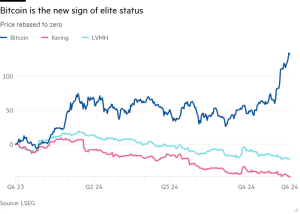Paying the price for European security
This article is an onsite version of our Europe Express newsletter. Sign up here to get the newsletter sent straight to your inbox every weekday and Saturday morning. Explore all of our newsletters here
Welcome back. No discussion of Europe’s future omits to place defence and security at or near the top of the list of policymakers’ priorities. For Nato’s European members, the aim is to deliver not just higher but better-quality defence expenditure.
Still, the obstacles to an integrated European defence effort are formidable — and the question of how far to involve the EU remains contested. I’m at [email protected].
A ‘true defence union’
In 2014, when Nato governments pledged to spend at least 2 per cent of GDP annually on defence, only three countries met the target. This year, 23 of the alliance’s 32 states will do so, according to Nato estimates.

In principle, then, there is progress. But the leaders who will run the EU’s Brussels-based institutions for the next five years say, correctly, that more needs to be done. They take the view that the EU can play a vital role in stimulating and co-ordinating an improved effort from national governments and defence industries.
Speaking at the European parliament in July, Ursula von der Leyen, the European Commission president, said:
For the first time in decades our freedom is under threat . . . I believe now is therefore the time to build a true European defence union.
An early sign of her commitment was her nomination of former Lithuanian premier Andrius Kubilius as the EU’s first defence commissioner.

The EU legislature has still to confirm the appointment of Kubilius. But he has wasted no time in airing proposals that, if put into effect, would define his five-year term.
One is to make EU governments stockpile minimum levels of ammunition and other supplies. Another, more controversial idea is to draw on unused tens of billions of euros in the EU’s post-pandemic recovery fund to ramp up defence expenditure.
Vulnerable Europe
The sense of urgency is not misplaced.
Writing for the US Council on Foreign Relations, Thomas Graham puts matters bluntly:
Currently, Europe is in no position to defend itself. Comfortable in its reliance on the US as its security guarantor after the cold war, it allowed its military forces and defence industries to atrophy to devote greater resources to raising standards of living.
As a result, European military forces cannot effectively operate without direction and material support from the US.
Now, Graham says, Europe has been “shocked out of its geopolitical slumber” by two developments: Russia’s full-scale invasion of Ukraine, and a possible second term in the White House for Donald Trump.
Legal and constitutional constraints
Various difficulties stand in the way of an EU-led defence effort. In this collection of articles for the EconPol Forum, a Germany-based research network, one essay highlights the problem of lack of co-ordination:
European states are not aligning their military spending priorities. For this reason, a simple increase in national defence spending does not automatically lead to a higher joint industrial and operational capacity of the EU but increases the risk of wasting the growing military resources.
Another article underlines the legal and constitutional constraints on the EU:
On the one hand, the EU treaties currently do not provide a fully fledged legal basis for a proper EU defence; on the other hand, several national constitutions (including the German, Italian, Irish and others) include clauses that limit what can be jointly achieved in terms of defence.
In this article for the UK in a Changing Europe think-tank, Delphine Deschaux-Dutard explains that, in spite of these constraints, the EU has launched some useful initiatives, mostly in response to Russia’s attack on Ukraine.
They include:
1. The European Peace Facility, which finances the delivery of military equipment to Ukraine
2. The Act in Support of Ammunition Production, which promotes collective European procurement of ammunitions
3. The European Defence Industry Reinforcement through Common Procurement Act, which sets up a fund to assist weapons purchases
Where to get the weapons?
Defence procurement poses a particular challenge for Europe. According to the French Institute for International and Strategic Affairs, EU countries announced over €100bn of defence purchases in the 15 months after Russia’s attack on Ukraine in February 2022.
Of that sum, 78 per cent represented armaments from outside the EU. The major suppliers were the US (80 per cent of non-EU procurement), South Korea (13 per cent) and Israel and the UK (3 per cent each).
The EU has programmes in place for a more self-reliant, collaborative European defence effort, especially in research and development, but the sums of money involved are small.
Defence industry executives and specialists recently drafted a report that highlighted shortcomings in the EU effort. “Companies are worried their collaborative outputs will be put on the shelf, never again to be looked at once EU funding runs dry,” Aurélie Pugnet wrote for the Euractiv news site.

Who should run the show?
Not all EU governments are convinced that von der Leyen’s commission should be handed more control over European defence policy.
In this FT article, Paola Tamma and Henry Foy quoted a senior EU diplomat as saying: “We would not accept a power grab by the commission.”
For good measure, this unnamed policymaker dismissed the idea of commonly issued EU defence bonds as “pure fantasy”.
Where will the money come from?
This raises the question of how to maintain or increase defence expenditure when budget deficits and public debt are already high in many EU countries after the 2008 financial crisis, the Covid pandemic and the subsequent energy crisis.
In a survey published this week by the World Economic Forum, some 53 per cent of chief economists identified public debt as a major risk to the stability of advanced economies.
The fiscal pressures facing EU governments are outlined in this authoritative European Central Bank study, which highlights the huge costs involved in addressing defence and security, demographic ageing, digitalisation and climate change. These are depicted in the ECB chart below.

However, the ECB makes the point that, if skilfully managed, higher defence spending could be beneficial for European economies and the public finances:
Additional defence spending could potentially increase GDP growth in the EU, with positive implications for fiscal sustainability in the longer term, if it (i) is concentrated in R&D-intensive investment, (ii) does not crowd out other productive investment, and (iii) focuses on EU-based sources.
EU budget
The fiscal constraints on defence spending are linked to the question of the EU’s next long-term budget, due to run from 2028 to 2034.
Any hope that the EU’s 27 states will reach an early consensus on the budget has been complicated by the domestic political weakness of President Emmanuel Macron in France and the troubles of Germany’s three-party ruling coalition.
After conversations this month with high-level policymakers in Brussels, Mujtaba Rahman of the Eurasia Group consultancy concluded that the budget debate will be extremely fraught. An expansion of the EU’s Covid-era joint debt issuance is far from certain, he says:
Opposition to more common borrowing is now so entrenched that most senior EU officials do not believe it will happen in the short term.
The small window that existed to do something more quickly — essentially between now and Germany’s federal elections in September 2025 — has effectively been closed by . . . Macron’s early election gamble.
This both weakened Macron’s voice in Europe and arrested the momentum that was building behind the idea of more common financing for intra-EU security and defence.
German blockage
To restore the momentum, there would need to be significant change in Germany, the EU’s largest economy.
After Russia’s 2022 full-scale invasion of Ukraine, Chancellor Olaf Scholz announced the creation of a €100bn fund for modernising Germany’s armed forces. But Rafał Ulatowski, writing for the Washington Quarterly, contends that there are good reasons to doubt whether this initiative has really transformed the country’s defence policy.
It’s not that Germany lacks the money. Rather, as Markus Jaeger argues in the Internationale Politik Quarterly, the problem is twofold.
First, Germany’s constitutionally enshrined “debt brake” imposes restrictions on deficit spending that hinder investment in defence.
Second, there are political constraints — “less in the sense of a lack of public support and more in terms of a lack of political leadership”.
Scholz’s coalition is on the ropes amid a rise in support for radical parties of right and left that oppose both support for Ukraine and an expanded defence effort.
In conclusion, the outlook for European security will be shaped not only by November’s US election result. A great deal hangs, too, on Germany’s Bundestag election a year from now.
Power for progress: why the EU needs a new global strategy — an essay by Giovanni Grevi for the Centre for Security, Diplomacy and Strategy at the Vrije Universiteit Brussel
Tony’s picks of the week
-
Chinese merchants have flooded online marketplaces to sell US presidential election merchandise, as Democrats and Republicans seek to promote locally made products in a campaign marked by hostility towards China, the FT’s Sun Yu reports from New York
-
Tuvalu, the Pacific coral island chain state, hopes to establish a legal basis for its continued sovereignty even if it disappears beneath the waves because of climate change, Kirsty Needham reports for Reuters news agency
Recommended newsletters for you
FT Opinion — Insights and judgments from top commentators. Sign up here
Chris Giles on Central Banks — Vital news and views on what central banks are thinking, inflation, interest rates and money. Sign up here
#Paying #price #European #security




